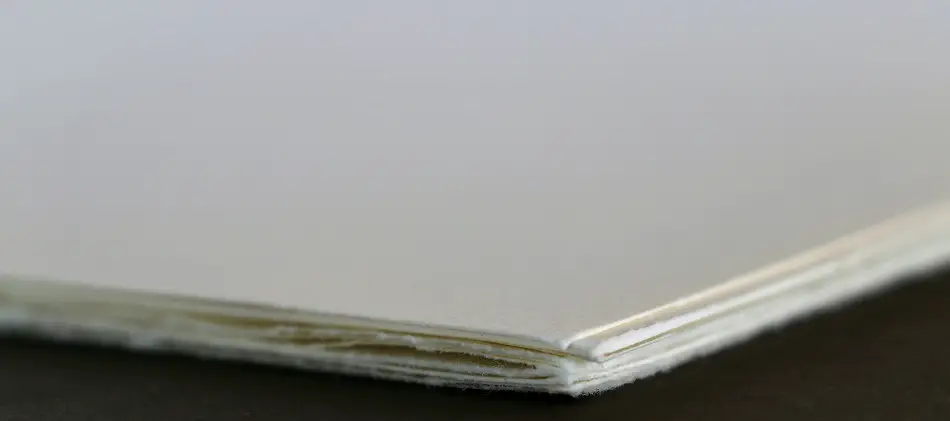Watercolor paper can be extremely confusing at first. It comes in a wide variety of textures, weights, and sizes which are not intuitively named for the most part. You really have to do some research to understand the options. Thankfully, I have done that research for you and compiled it here!
Watercolor paper is an integral part of watercolor painting; therefore, you should choose wisely to best suit YOUR needs/desires. There are many different types of paper available, each with its own qualities that will affect how your work turns out. In this post, I discuss the various weights of watercolor papers, standard sizes, binding type (sheet, pad, block, or roll), as well as which is the best option for your projects!
What Is Watercolor Paper, And Why Does It Matter?
Watercolor paper is a surface created specifically for use with watercolor paints. It is absorbent and durable. It can be made from wood pulp, cotton, or a combination of these. The purer cotton the “paper” is, the more durable it is, but also the more expensive.
You cannot use regular paper for watercolor painting because it disintegrates with the amount of water necessary. You cannot use traditional prepped canvas because it is not absorbent like watercolor paper is. Watercolor requires either watercolor paper or a surface specifically prepared with an absorbant “ground.”
Watercolor Paper Types (Quality)
There are a few types of watercolor paper, but it can mainly be broken down into academic and professional quality.
Academic quality watercolor paper is less expensive. It is typically made of wood pulp because it is cheaper than cotton. Usually, it will be 100% acid-free so that the paper will not yellow over time. The main differences are this paper will not be as durable or absorbant as professional quality.
Professional quality paper will be 100% cotton and again acid-free. This paper will offer more absorbency and more durability. If you are just sketching and practicing, you may not want to spend the extra money for this quality of paper. If you are laying many paint washes or making paintings to frame or sell, you would want to invest in professional quality paper.
Watercolor Paper Texture
Watercolor paper comes in three textures. Rough, cold-pressed (called “not” in the UK), and hot-pressed. Rough is the most textured and most absorbent, ideal for washes. Hot-pressed is the smoothest and least absorbent, ideal for detailed paintings. Cold-pressed is the middle ground between the other two.
Rough
Rough watercolor paper is actually the most self-explanatory. It is the most textured option and the most absorbent option.
This paper texture is achieved by pressing the pages between textured felt (usually) during manufacturing.
Rough watercolor paper is the best option for a smooth gradient wash and when you do not want fine details in your finished work. The paint will blend smoothly and not puddle due to the absorbency level, but the rough texture makes it difficult to achieve straight distinct lines.
Cold-pressed (UK-“Not”)
Cold-pressed watercolor paper, called “Not” (as in “not” hot-pressed….face-palm), is created by pressing between cold metal rollers during the drying process. This creates a moderately smooth texture, but it will still be textured!
This is an excellent option for most projects. It is the middle ground when it comes to texture. It absorbs well, so it does well for washes like rough paper, but it is less bumpy, so you can paint some fine detail. It will allow for some “blooming” in your painting while not going overboard.
This is the most common option available, and if you do not know what you have been painting on because you didn’t seek out that info when you first purchased, this is likely what you have.
Hot-pressed
Hot pressed watercolor paper is created by pressing the paper between two hot metal rollers during drying. This essentially acts as an iron to flatten out all of the bumps/texture on the paper.
This paper is not very absorbent. Because of this, it is not great for color washes. The paint will puddle and will not create an even wash. It is AWESOME for creating fine details and delicate paintings. I think of the watercolor paintings of anatomically correct butterflies. Those are soooo detailed and precise! They must be done on this type of paper!
Watercolor Paper Weight
So now we start getting a little confusing.
Watercolor paper comes in different “weights.” This basically refers to the thickness of the paper, though there is more to it than just that. But for our purposes as consumers, that is pretty much what matters.
In the US, weight is designated in pounds and refers to how much 500 sheets of the paper would weigh. In Europe, it is labeled in grams and refers to the number of grams per meter squared. No, I don’t know why it is labeled this way… It seems kinda confusing to me. Anyway…
Here are the common weights.
- 90 lb or 185 gsm
- 140 lb or 300 gsm
- 280 lb or 600 gsm
- 300 lb or 640 gsm
Each weight of watercolor paper offers unique qualities. In general, 90 lb is the lightest and is not suited for painting, only sketching. 300 lb is the heaviest and most expensive. It will not warp with heavy amounts of water.
90 lb is not really suitable for painting. It is okay for watercolor sketches and ink, but it will buckle significantly if too much water is applied.
140 lb is medium weight and is the most common, esp in pads/journals. It will still warp if too much water is used, but it can be stretched to address this issue.
280 or 300 lb is typically the heaviest weight available, and it is also the most expensive. For this reason, it is not as commonly used. The best part about this heavy of paper is it does not really warp and does not require stretching before use.
Watercolor Paper Sizes
Again, confusing category. You wouldn’t think it would be, though, right? We have 8″x10″, 14″x16″….oh no, no, no. Not in watercolor paper!
There are two standardized forms for watercolor paper measurement for paper sold in sheets. The first is an English system called “Imperial.” In this system, the sizes are named Imperial, Half Imperial, Medium, Royal, and Super-Royal. (There are others as well, but these seem to be most common). The second system is a metric system called “A sizes.” In this, the sizes are named A0-A7.
Below are tables detailing the dimensions. And I included inches and mm for both systems (just in case your brain only works in one of them like mine!)
| A Sizes | Dimensions (mm) | Dimensions (Inches) (approximate) |
|---|---|---|
| A0 | 841 x 1189 | 33.1 x 46.8 |
| A1 | 594 x 841 | 24 x 33.1 |
| A2 | 420 x 594 | 16.5 x 24 |
| A3 | 297 x 420 | 11.7 x 16.5 |
| A4 | 210 x 297 | 8.3 x 11.7 |
| A5 | 148 x 210 | 5.8 x 4.1 |
| A6 | 105 x 148 | 4.1 x 5.8 |
| A7 | 74 x 105 | 2.9 x 4.1 |
| Imperial Sizes | Dimensions (mm) | Dimensions (inches) |
|---|---|---|
| Imperial | 559 x 762 | 22×30 |
| Half Imperial (Demy) | 381 x 559 | 15×20 |
| Medium | 457 x 584 | 18×23 |
| Royal | 508 x 635 | 20 x 25 |
| Super-Royal | 508 x 711 | 20 x 28 |
Pads are kinda like sketchbooks and they are may be listed with the sizes listed above or may just have the dimensions listed.
Watercolor paper can also be sold in rolls which is not standardized in size. The dimensions will be listed. A roll may be anywhere between 36 and 60 inches wide and 10-20 yards long.
Watercolor Paper Binding
Watercolor paper is sold either loose sheet, rolled, or bound in either pads or blocks.
Loose sheets are nice because they can be painted as-is or cut to a specific size that you want. They are not great for portability, though.
Rolled paper is great for large works because it can be cut larger than loose sheets. It is also a more cost-effective option.
Pads are often bound and labeled as “journals” or “sketchpads.” They are either spiral bound (like a notebook) or gummed (glued) on one edge. With both of these options, you can flip through them like a book. They are great for portability. They are typically medium weight and cold-pressed, though if you dug, you could find other options. Because they are generally medium weight, the pages may warp during your painting if using heavier washes/more water.
Blocks are sheets that are gummed (glued) on all four sides. These are offered in different weights and sizes. They are great because they prevent the work from warping as they are secured on all four edges! They aren’t quite as portable as pads, though still better than single sheets. They also are more expensive than pads.
With all the information you’ve learned, the next time you purchase watercolor paper, you can feel confident that you are making a wise choice. Hopefully, this post has helped answer any questions about different types and sizes of watercolor paper so that now it will be easier to make an informed decision when shopping!
Now it is time for YOU to get Crafty with Ashy!
Be sure to subscribe and follow me so you don’t miss any inspiration!





Finally an explanation a beginner can grasp re watercolor paper! Thanks!
Oh yay! Thank you for taking time to leave feedback! I’m glad it was helpful for you!